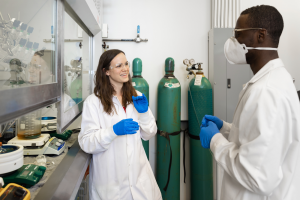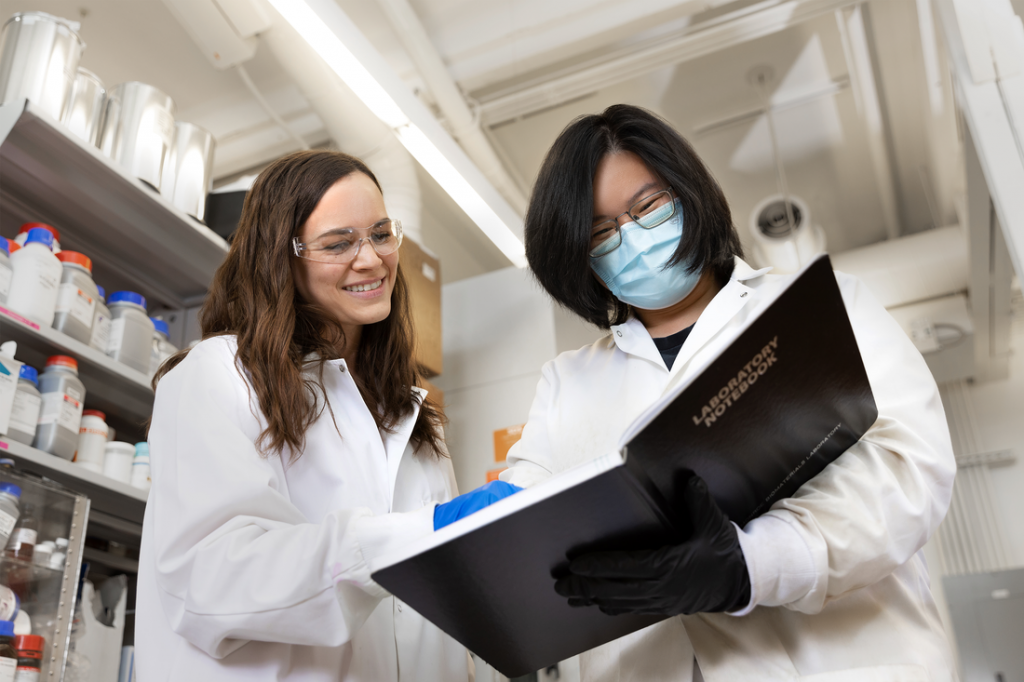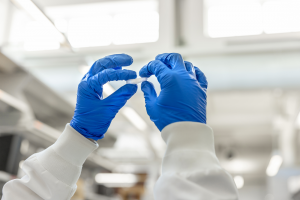When Syracuse University student Natalie Petryk ’21, G’22 wanted hands-on training in tissue engineering, she sought out Mary Beth Monroe. The illustrious professor couldn’t wait to show Petryk how synthetic materials can be used to repair damaged human tissue and organs.
“Professor Monroe immediately found a way to incorporate cell work into a research project I was doing,” recalls Petryk, a recipient of bachelor’s and master’s degrees in bioengineering. “She truly cares about our interests as students and researchers and helps us find projects that meet our academic and professional goals.”
Monroe was a newcomer to the College of Engineering and Computer Science when she started mentoring Petryk. Their relationship has since flourished, with Petryk poised to begin Ph.D. studies in bioengineering and Monroe regarded as one of the field’s rising stars. “Professor Monroe has inspired me in so many ways,” she says. “I couldn’t be more grateful.”
Monroe credits success to a culture of reciprocity with her students in the Department of Biomedical and Chemical Engineering (BMCE). “Just as my faculty mentors afforded me special opportunities when I was a student, I want to give members of my lab, many of whom are women, something they can’t get anywhere else,” says Monroe, who designs shape-memory polymers (SMPs)—materials made of chains of molecules that can return from a deformed shape to their original shape with the application of an external stimulus, like heat or moisture. “This fosters a sense of community, which drives learning and research.”
Reducing Risks, Improving Outcomes
Monroe came to Syracuse University in 2018 after a decade-long stint at Texas A&M University, where she earned a Ph.D. in biomedical engineering and served as a National Science Foundation (NSF) Graduate Research Fellow. “Everything I do has a medical application,” says Monroe, who also was a National Institutes of Health (NIH) National Research Service Award Postdoctoral Fellow in the Texas A&M Health Science Center. Today, she inhabits Syracuse’s BioInspired Institute, a crucible of world-class interdisciplinary research.

It’s no surprise that federal agencies are lining up to support Monroe’s work—the NSF, the NIH, the U.S. Air Force.
The private sector is also taking notice. The Crohn’s & Colitis Foundation is underwriting her research into fistula treatment. Described as a chronic wound that strikes the urinary, reproductive and digestive systems, a fistula can lead to painful infections and abscesses.
Monroe estimates that 80% of Crohn’s fistula patients require surgery. “A fistula takes a long time to heal,” says the native Texan, who recently co-authored a paper on the subject in the Journal of Biomedical Materials Research. “There’s big demand for nonsurgical treatment options because they’re less painful. These options also can help patients recover faster and cut down chances of recurrence.”
Monroe’s lab has developed an SMP hydrogel that, when inserted into a wound, responds to body heat by expanding and filling the fistula opening. The SMP’s starch-based scaffold then breaks down in the presence of colonic cell enzymes.
“There’s no need to remove anything afterward,” says Monroe, adding that the SMP hydrogel also has antioxidant and antimicrobial properties—preventing cell damage and stopping harmful microorganisms in their tracks. “It reduces infection risks and improves healing outcomes.”

From Lab to Market
Monroe’s lab also makes nonsurgical SMP foams for hemorrhage control. Studies show that uncontrolled bleeding is the top cause of preventable death from trauma, annually claiming 1.5 million lives worldwide. Half of these deaths occur en route to the hospital.
“SMP foams have military and civilian applications, especially with gunshot wounds,” says Monroe, whose devices are still in the research and development phase. “The first five to 10 minutes of severe bleeding are the most critical—often the difference between life and death.”
Monroe seeks a solution that controls blood loss more effectively than conventional gauze and tourniquet treatments, which generally need to be removed within 12 hours. The result? A degradable SMP foam that, like its hydrogel counterpart, is stimuli responsive. After being heated, compressed and cooled, the SMP foam is implanted in the wound, where it reheats to body temperature and expands. “The SMP foam hits all the wound walls, applying pressure and inducing clotting,” she says.
It takes Monroe two days to make a large batch of SMP foam in her lab. Afterward, she and her students slice it into small, Cheeto- or pen-shaped samples. Their texture is like that of a kitchen sponge, with polyurethane—the foam’s magic ingredient—providing a kind of biocompatible dressing to stop blood loss.
If all goes to plan, her SMP foams will be on shelves in about five years.
BMCE chair Julie M. Hasenwinkel notes Monroe’s flair for innovation and entrepreneurship. “She recognizes the interdependence of basic and applied research—that an understanding of polymer properties can increase the utility of biomaterials,” Hasenwinkel says. “As a result, her students get an up-close look at how technology moves from lab to market.”
A Courageous Role Model
Hasenwinkel considers Monroe a courageous role model and an advocate for diversity and equity in the male-dominated field of engineering. “The issue is not just about women being underrepresented or earning less money,” says Monroe, who juggles teaching and research with raising two children. “STEM works best when there’s a wide range of perspectives. The more diverse and inclusive the workplace is, the happier—and more productive—everyone can be.”

Monroe is resolute in her efforts to support women in STEM. A member of the long-running Women in Science and Engineering (WiSE), she also has founded Women in BMCE, the Women Faculty Peer Mentoring Group and the off-campus Retirement Community Research Outreach Program.
Maryam Ramezani, a Ph.D. candidate in Monroe’s lab, attends the biannual Women in BMCE dinner, which rotates among various professors’ homes. Each event draws 30-35 attendees who informally discuss the adventures and challenges of being a woman in STEM. “The dinners are important for us,” says Ramezani, who has been twice recognized by the Society for Biomaterials, whose student chapter Monroe advises. “We feel supported, which probably explains why there are so many women in Professor Monroe’s lab.”
Ramezani remembers preparing for her doctoral qualifying examination when Monroe encouraged her to join WiSE. “It was the dawn of the pandemic, and I was very stressed. I didn’t think I had time to participate,” admits the Iranian-born bioengineer. “But Dr. Monroe reminded me that pursuing a Ph.D. is about being professional in all respects, not just working in a lab. She talked me into it.”
An avid supporter of the U.N.’s International Day of Women and Girls in Science (Feb. 11), Monroe considers gender balance an academic imperative. For this reason, she regards her students as beneficiaries as well as agents of change. “One way to close the gender gap is to be taught by someone who looks like you,” Monroe says. “I’ve always had good mentors, and I hope I can be that kind of person to some of my female students. Teaching—and doing research—is about making a difference.”
-by Rob Enslin
